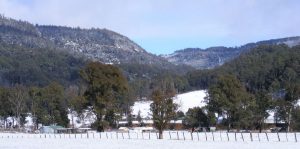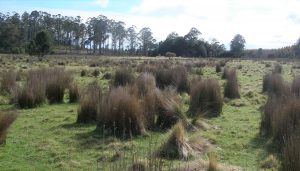The most famous Gads Hill stockman was Harry Stanley (1820–98), a tiny (162-cm tall), illiterate, former Sussex basket weaver transported for horse stealing as a 21-year-old in 1841—although his version of events was that he simply held a rope, which happened to have two horses at the end of it.1 He served two years in probation gangs at Lovely Banks and Bridgewater, and received at least 49 stripes on the back for idleness and refusing to work.2 Yet he happily—in retrospect, at least—helped bear Jane Franklin aloft in her sedan chair during her trek to Macquarie Harbour in 1842, the story becoming his hearth-side staple for decades afterwards.3 Stanley claimed to have been a fixture at Howells Plains and Gads Hill since driving Humphrey Howells’ first stock through from Bothwell to the plains in 1845—although his conduct record suggests it must have been at least four years later.4 He had a hut at both cattle runs, probably replacing Tom Shaw as Gads Hill stockman in 1883.5 Highland journalist Dan Griffin reckoned his Gads Hill fleas were big enough to double as pack-horses.6 Stanley was the king of snake stories and had killed his share of tigers.7 In May 1888 Harry’s dogs reportedly killed two half-grown thylacines at the Top Paddock, Borradaile Plain, while he was guiding a party across the plain.8

Visitors to Fields’ Gads Hill Station in the late 1880s and through the 1890s described fenced, grassy paddocks with a coverage of clover quite capable of fattening stock.9 Stanley’s only busy time would have been during the annual muster, when hundreds of cattle were driven back from highland outposts further afield. Gads Hill Station was a staging post on such drives, its holding paddock enabling straggling stock to be gathered for the plunge down to the Mersey bridge. Stanley’s pack of dogs would have been trained to rein in a bull as well as hunt down a wallaby, but he also had several cats around his hut and, at one time, a blind rooster, whose list of talents may have varied according to the degree of his master’s sobriety.10 Because Stanley liked a drink, as an 1893 traveller discovered:
An old man came out of the hut; shading his eyes with a brown and bony hand to look at us. Then he limped towards us with apparent pain.
‘S’help me bob, gemmen,’ the old man gasped as he stopped in front of us, ‘yer jest in time ter save a pore cove’s life.’
The boy with the pack horse winked as if he wanted to get rid of his left eyelid. ‘What’s the matter, Harry?’, he asked the old man.
‘Cramps—cramps in me stummick—ugh!’ the old man answered as he squirmed, ‘If I had but a drop o’summat shurt as ‘ud do it good, I’d be right.’
The effect of giving him whisky was ‘marvellous’:
The old man became erect, lively, garrulous, and obliging, and invited us to share his hut for the night. 11
Shared interests are a bond, and Stanley’s partner Mary, née Connors (alias Donovan, c1833–1900), also liked to wet her whistle. She was a native of County Cork transported for life as a sixteen-year-old maid for allegedly burning a house—her first offence—in 1849.12 Even tinier (150 cm tall) than Harry, and pock-marked, she had been assigned to various settlers at the Macquarie River, in Hobart, Huon River, Kempton and Sorell before obtaining a ticket of leave in 1854.13 In the following year she acquired permission to marry ex-convict Robert Jones.14 Presumably she was pregnant with their Hobart-born son called either William Robert Jones or Thomas William Jones, but the marriage never took place, and in her last years she was long estranged from her only son.15 She was in the Deloraine district and known as Mary Stanley by the 1880s, when fined twice for being drunk and disorderly.16 By 1889 she kept a boarding house on the western bank of the Mersey River, Liena, at the base of Gads Hill.17 Ironically, the Irish incendiarist was later said to be the guardian angel of the Mersey Bridge, protecting it from bushfire. Her boarding house, which accommodated various travellers—surveyors, track builders, mining men and the occasional journalist—was clean and comfortable, providing a stark contrast to that offered by her partner’s abode higher up the hill.

Mary Stanley, wearing an apron, is glimpsed standing in the background before her Liena premises in March 1898, when she boarded members of a Launceston Examiner party travelling the Mole Creek Track. The others pictured are probably packers Phil Parsons, Knowles and Wilson, and Launceston Examiner editor FJ Prichard, order uncertain.
Stephen Spurling III photo from the Launceston Examiner.
The Stanleys were a unique double act. Not for their open plan marriage, but because husband and wife both claimed the government thylacine bounty.18 While it is possible that Mary claimed her 1895 bounty on behalf of Harry, it is also likely that, like him, she set snares for wallabies, pademelons and possums on the edge of the grasslands at the base of Gads Hill. Thylacines were not only run down by dogs but were particularly vulnerable to necker snares, often being strangled in snares set for other animals.

Harry Stanley succumbed to exposure after lighting a campfire to warm himself up on a snowy day at the Bottom Plain near Howells Plain in 1898.19 An obituarist described him tactfully as ‘one of Tasmania’s notorieties’.20 Learning of his aid to Jane Franklin, one of her Hobart friends wanted to raise a memorial tablet in his honour ‘in whatever church Stanley was a member’.21 The fact that he lies in an unmarked grave in the Chudleigh Pioneer Cemetery probably answers the question of his congregational allegiance. The site of his hut at Howells Plain disappeared under the hydro-electric dam impoundment of Lake Rowallan, but was revealed recently when the lake was drained for dam maintenance purposes.
Mary Stanley probably rests beside her partner, having drawn her last breath of Mersey air in 1900.22 Anonymous in death, they are partly preserved in our rich newspaper and penal archive, where the stories of the disenfranchised vastly outnumber those of the convict made good.
Copyright Nic Haygarth 2020
[1] Conduct record, CON33/1/9, image 230 (TAHO), https://stors.tas.gov.au/CON33-1-9$init=CON33-1-9p230, accessed 6 September 2019; Sydney (Bill) James, The blazed track, p.65.
[2] Conduct record, CON33/1/9, image 230 (TAHO).
[3] The Tramp’ (Dan Griffin), ‘A few weeks in the mountains’, Daily Telegraph, 25 December 1894, p.3.
[4] Conduct record, CON33/1/9, image 230 (TAHO).
[5] ‘Country news’, Launceston Examiner, 16 March 1897, p.7.
[6] ‘The Tramp’ (Dan Griffin), ‘A few weeks in the mountains’, Daily Telegraph, 25 December 1894, p.3.
[7] Mark Shaw; quoted by Kerry Pink, ‘New chapter in Western Tiers story will be for all to read’, Advocate, 12 January 1963, p.11.
[8] ‘The Tramp’ (Dan Griffin), ‘From Gads Hill to the West Coast’, Colonist, 19 May 1888, p.4. This was within the first month of the government thylacine bounty scheme, and no Stanley claim for two juveniles is recorded.
[9] See, for example, ‘Peregrinator’, ‘Notes of a trip in the vicinity of Cradle Mountain’, Colonist, 17 March 1888, p.4; or ‘The way to the west’, Launceston Examiner, 26 February 1897, p.3.
[10] ‘The Tramp’ (Dan Griffin), ‘From Deloraine to Gads Hill’, Colonist, 18 February 188, p.7.
[11] ‘Beautiful Tasmania: no.10: In forest and mountain wilds’, Launceston Examiner, 17 June 1893, p.10.
[12] Conduct record, CON41/1/26, image 31 (TAHO), https://stors.tas.gov.au/CON41-1-26$init=CON41-1-26p32, accessed 6 September 2019. There were two Mary Connors on the Earl Grey, image 31 and 32. She is distinguished by being the one who obtained permission to marry Robert Jones. See also ‘The Tramp’ (Dan Griffin), ‘From Deloraine to Middlesex’, Colonist, 2 November 1889, p.12.
[13] Conduct record, CON41/1/26, image 31 (TAHO).
[14] Permission was granted 30 January 1855, see CON52/1/7, p.222 (TAHO), https://librariestas.ent.sirsidynix.net.au/client/en_AU/names/search/results?qu=Mary&qu=connor&qf=NI_INDEX%09Record+type%09Marriage+Permissions%09Marriage+Permissions&qf=NI_NAME_FACET%09Name%09Connor%2C+Mary%09Connor%2C+Mary+%7C%7C+Connors%2C+Mary%09Connors%2C+Mary&qf=PUBDATE%09Year%091855-1858%091855-1858#, accessed 6 September 2019.
[15] ‘The Tramp’ (Dan Griffin), ‘From the Iris to Deloraine: no.4’, Daily Telegraph, 29 June 1893, p.3; ‘Deloraine’, North Western Advocate and the Emu Bay Times, 6 April 1900, p.2. Griffin claimed that her native place was O’Briens Bridge, County Limerick.
[16] Deloraine Court records, 12 April 1884, p.30; and 10 June 1886, p.70, POL126/1/3 (TAHO). In the latter instance the wrong ship name, William Hammond, was given, this being a vessel which arrived in Western Australia in 1856 with 89 passengers and 256 male convicts. Her age was given as 52 and 54 years respectively.
[17] ‘The Tramp’ (Dan Griffin), ‘From Deloraine to Middlesex’, Colonist, 2 November 1889, p.12.
[18] Henry Stanley claimed bounties no.76, 17 September 1888, p.121 (1 adult and 1 juvenile), and no.279, 11 January 1889, LSD247/1/1. Mary Stanley claimed bounty no.349, 15 January 1895, p.39, LSD247/1/2 (TAHO).
[19] Died 1 August 1898, death record no.148/1898, registered at Deloraine, RGD35/1/67 (TAHO), https://librariestas.ent.sirsidynix.net.au/client/en_AU/all/search/results?qu=henry&qu=stanley, accessed 6 September 2019. He was described as a stock-rider, 78 years old, and died of exposure. See also the inquest into his death, which gave cause of death as ‘death by cold and exposure accelerated by old age’: inquest no.10948, SC195/1/72 (TAHO), https://librariestas.ent.sirsidynix.net.au/client/en_AU/names/search/results?qu=henry&qu=stanley&qf=NI_INDEX%09Record+type%09Inquests%09Inquests, accessed 6 September 2019.
[20] ‘Found dead in the snow’, Mercury, 3 August 1898, p.3.
[21] ‘In memoriam’, Launceston Examiner, 10 August 1898, p.4.
[22] ‘Deloraine’, North Western Advocate and the Emu Bay Times, 6 April 1900, p.2.
All ways enjoy reading your work keep digging up Past great Tasmanian history we are so fortunate to have grown up here and live here.
Thanks Nic .. great article